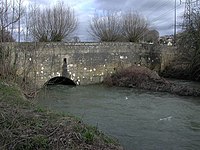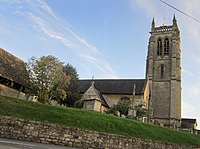Bathford
| Bathford | |
| Somerset | |
|---|---|
 High Street, Bathford | |
| Location | |
| Grid reference: | ST793666 |
| Location: | 51°23’58"N, 2°18’15"W |
| Data | |
| Population: | 1,753 (2001) |
| Post town: | Bath |
| Postcode: | BA1 |
| Dialling code: | 01225 |
| Local Government | |
| Council: | Bath & NE Somerset |
| Parliamentary constituency: |
North East Somerset |
Bathford (pronounced with the emphasis on the second syllable) is a village in Somerset, three miles east of Bath. The parish, which includes Warleigh, had a population of 1,753 in 2001 and extends over 1,800 acres.
The village is within the Bath Forum Hundred.
Geography
The old walled village of Bathford is located on the A363, less than a mile south of the A4. Bathford Bridge is where the A363 crosses the By Brook (aka Box Brook, The Weaver and Withy Brook). The original bridge was built in the thirteenth or fourteenth century to replace the ford which gave the village its name.[1]
Bathford extends up one side of the Avonvale Valley. There are several routes up to the valley ridge, which was once the site of active stone quarrying. This ridge offers commanding views of the valley below and also of nearby Solsbury Hill.
Churches
St Swithun's Church, parts of which may date from the twelfth century, is the resting place of Admiral Lord Nelson's sister, Ann. The church has Romanesque origins and the dedication to St Swithun is thought to have been in 1323.[2]
The north aisle and porch were added in 1856. The south aisle and nave in 1870-72 and the west tower between 1879 and 1880.[3]
History
The ancient charter Codex Diplomaticus Aevi Saxonici describes a manor parish consisting of three tithings or quasi manors; Bathford in the centre, Shockerwick to the north Warley [Warleigh] to the south. This corresponds very closely to the current boundaries. This manor was known as Forde up until the seventeenth century. The name was derived from the ford that crosses the By Brook, connecting Bathford to neighbouring Bathampton.
Near the river crossing is the site of a Roman villa, the hypocaust of which was found about the middle of the seventeenth century. This villa is described in this extract from John Aubrey's Monumenta Britannica;
- "At Bathford (near the citie of Bathe) was found by digging of a drayning trench deeper than ordinarily in the grounds of Mr Skreene, in the year 1655 a roome underground, which was about 14 feet one way and 17 feet the other. The pavement of which was opus tesselatum [tesselated work] of small stones of several colours. viz., white (hard chalk), blue (liasse), and red (fine brick). In the middle of the floor was a blue bird, not well proportioned, and in each of the four angles a sort of knott. This ground and the whole manor did belong to the Abbey of Bath. Underneath this floor there is water. The floor is borne on pillars of stone about an ell distant the one from the other. On the pillars were laid plank stones on which the opus tesselatum was layd. The water issued out of the earth a little below, and many persuade themselves there is much water in it. This discovered place was so much frequented that it caused Mr Skreene to cover it up again, because the great concourse of people, especially from Bathe, injured his grounds, but he would not cover it so soon that the people had torn up all the work before I came hither to see it, but his daughter-in-lawe hath described the whole floor with her needle in gobelin-stitch. Mr Skreene told me there is another floor adjoining yet untouched."[4]
The ford from which the village derived its name was connected with the Fosse Way. This is mentioned in a Saxon charter of the tenth century relating to the manor.[5] The Fosse Way stills forms the boundary of the parish.
The old Bathford railway bridge was built by Isambard Kingdom Brunel as part of the old Great Western Railway.[6] The station of Bathford Halt used to exist but closed in 1965.[7]
Near Bathford, on the opposite side of the river, is a large meadow known as Horselands where, according to tradition, the Roman cavalry were exercised. More recently, the area bounded by Ostlings Lane and the Bradford Road (A363) was used to keep the spare horses used to haul the mail coaches up Bathford Hill. They then returned to the field to await the next coach. Some of the older long-standing residents of Bathford still refer to Ostlings Lane as Horses Lane. Whether the two areas are related is somewhat uncertain.
Landmarks
Shockerwick House was built as a country house around 1750 by John Wood the Elder and is now offices and a nursing home. It has been designated as a Grade I listed building.[8]
Culture
Bathford has had its own festival known as Bathford Summer Festival since 2008.[9] It also has its own theatrical group, the Bathford Players.
Outside links
| ("Wikimedia Commons" has material about Bathford) |
References
- ↑ Bridges – The Bathford Society
- ↑ The Parish Church of St Swithun, Bathford – History
- ↑ National Heritage List 1016653: Parish Church of St. Swithun
- ↑ Aubrey, John (1982). Monumenta Britannica: a Miscellany of British Antiquities. Little Brown & Company. ISBN 0-316-05907-2.
- ↑ "Historic Bathford". Bathford Society. http://www.bathfordsociety.org.uk/content/about_bathford/about_bathford_main.htm. Retrieved 6 September 2009.
- ↑ National Heritage List 1016741: Railway bridge for under- pass
- ↑ National Monuments Record: No. 499392 – Bathford Halt
- ↑ National Heritage List 1019249: Shockerwick House
- ↑ "Rightnotes". Bath Chronicle. http://www.thisisbath.co.uk/news/Rightnotes/article-2390352-detail/article.html. Retrieved 7 March 2011.

